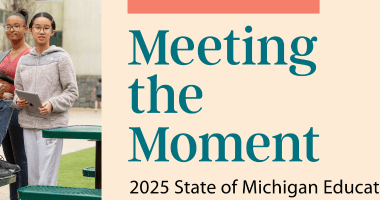The Unfinished Work of <I>Brown</I>
Sixty-three years ago this week, the United States Supreme Court shocked the nation by publicly stating what so many Americans already knew: that separate is inherently unequal.
Through their landmark decision in Brown v. Board of Education, the court formally ended our nation’s practice of enforced segregation in our schools, enshrined in the 1896 doctrine of “separate but equal.”
Through the lens of history, we know that Brown was merely a beginning to reversing Jim Crow. After all, Brown came a year before Rosa Parks refused to give up her seat. It came three years before the 101st Airborne was called in to Little Rock, so that nine African American children could attend Central High School. Four years before Ruby Bridges went through first grade alone in New Orleans, and nine years before George Wallace blocked Black students from entering the University of Alabama and 200,000 Americans marched on Washington.
As Dr. King so eloquently taught, “the arc of the moral universe is long, but it bends towards justice.” We have come a long way, but have much further still to go. As we celebrate and reflect on the importance and legacy of Brown, let us not forget that the fight for equity is ongoing, and that in far too many places, grave injustices still remain.
At a time when states and schools across the country are debating what educational accountability should look like, and how we factor in the educational quality of students who have been historically left behind, the stats should shock us all into action.
Based on the most recent state assessment results, the sad reality is that in Michigan, just one in five African American students is considered proficient in third-grade English language arts, compared to over half of white students. In eighth grade math, Hispanic students are half as likely as their white peers to be proficient, while fewer than 10 percent of African American students are proficient. And the dropout rate for African American, Hispanic and low-income students is twice that of their white peers.
Racial and economic segregation continues to persist in communities across the state, in many cases becoming more segregated than before.
Take Detroit, where 82 percent of students in the public school district are African American, compared to neighboring Grosse Pointe, where 75 percent of students are white. In Detroit, fewer than 10 percent of African American students are proficient in third grade reading and writing, while nearly 85 percent of white 3rd graders are in Grosse Point.
| Detroit Public Schools Community District | Grosse Pointe Public Schools | |||
| African American (82.4%) | White (2.2%) | African American (16.5%) | White (75.4%) | |
| 3rd Grade ELA | 9% | 13% | 63.9% | 84.5% |
| 8th Grade Math | 5.7% | <5% | 9.1% | 63.8% |
| Graduation Rate (4 Year) | 78.1% | 58.9% | 88.7% | >95% |
2015-16 M-STEP and Graduation Rates.
And this isn’t a problem limited to metro Detroit.
In Grand Rapids Public Schools, nearly 70 percent of students are African American or Hispanic, but in neighboring East Grand Rapids, more than 90 percent of public schools students are white. And much like Detroit, we see that these students, largely separated by race, continue to receive an inequitable education. When a white eight-year-old in East Grand Rapids is four times more likely to be a proficient reader than a Latino eight-year-old in neighboring Grand Rapids, we cannot claim to be providing equal opportunity and equal access.
| Grand Rapids Public Schools | East Grand Rapids Public Schools | ||||
| Latino (36.5%) | African American (32.2%) | White (23.1%) | African American (3.1%) | White (90.3%) | |
| 3rd Grade ELA | 17.2% | 18.2% | 47.4% | 50% | 79% |
| 8th Grade Math | 9.9% | <5% | 36.2% | <10% | 67.6% |
| Graduation Rate | 70.5% | 66.3% | 56.4% | >95% | 91.94% |
2015-16 M-STEP and Graduation Rates.
When just 6 percent of African American eighth grade students in Ypsilanti Community Schools are proficient in math, yet white peers in neighboring Ann Arbor have proficiency rates of 68 percent, we should be appalled and demand change.
| Ypsilanti Community Schools | Ann Arbor Public Schools | |||
| African American (60.9%) | White (22.5%) | African American (13.8%) | White (54.3%) | |
| 3rd Grade ELA | 12.6% | 31.8% | 26.4% | 69.1% |
| 8th Grade Math | 6.4% | 29.4% | 25.6% | 68.1% |
| Graduation Rate | 64.2% | 70.4% | 75% | 91.7% |
2015-16 M-STEP and Graduation Rates.
Six decades ago, the U.S. Supreme Court took a bold stand in declaring that separate was inherently unequal. While there is no question that progress has been made, there is also no doubt that our work is far from over.
Gross inequities in the quality of education for African American and Latino students remain. While our students have no ability to change this devastating reality, they will live the consequence of our inaction. As we move forward in our conversations around educational accountability and quality, let us bring these stark realities out of the shadows and ensure that every conversation begins with an open conversation about educational equity.






